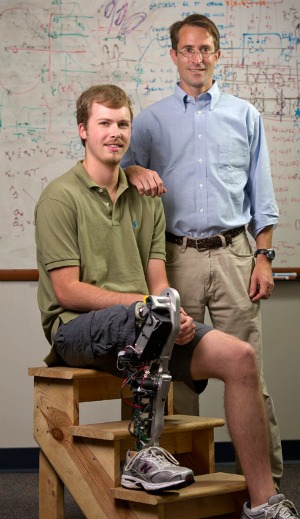New ‘bionic’ leg gives amputees a natural gait
August 18, 2011

Professor Michael Goldfarb, right, with amputee Craig Hutto who is wearing the new bionic leg developed at Vanderbilt (credit: John Russell, Vanderbilt University)
A new lower-limb prosthetic that allows amputees to walk without the leg-dragging gait characteristic of conventional artificial legs has been developed at Vanderbilt University.
The device uses the latest advances in computer, sensor, electric motor, and battery technology to give it bionic capabilities. It’s the first prosthetic with powered knee and ankle joints that operate in unison. It comes equipped with sensors that monitor its user’s motion. It has microprocessors programmed to use this data to predict what the person is trying to do and operate the device in ways that facilitate these movements.
“When it’s working, it’s totally different from my current prosthetic,” said Craig Hutto, the 23-year-old amputee (a shark-attack victim) who has been testing the leg for several years. “A passive leg is always a step behind me. The Vanderbilt leg is only a split-second behind.”
The prosthesis is designed for daily life. It makes it substantially easier for an amputee to walk, sit, stand, and go up and down stairs and ramps. Studies have shown that users equipped with the device naturally walk 25 percent faster on level surfaces than when they use passive lower-limb prosthetics. That is because it takes users 30 to 40 percent less of their own energy to operate.
Recent technological advances have allowed the engineers to produce a device that weighs about nine pounds (less than most human lower legs) and can operate for three days of normal activity, or 13 to 14 kilometers of continuous walking, on a single charge. They have also dramatically reduced the amount of noise that the latest model makes, although it is slightly louder than they would like.
One of the latest capabilities that the engineers have added is an anti-stumble routine. If the leg senses that its user is starting to stumble, it will lift up the leg to clear any obstruction and plant the foot on the floor.
The university has granted exclusive rights to develop the prosthesis to Freedom Innovations, a developer and manufacturer of lower limb prosthetic devices.
Vanderbilt’s Center for Intelligent Mechatronics is also developing an anthropomorphic prosthetic arm project and an advanced exoskeleton to aid in physical therapy.
